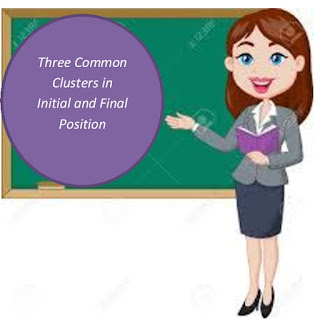Lesson Plan of Three Common Clusters in Initial and Final Position English Grade V
Lesson Plan of Three Common Clusters in Initial and Final Position
English Grade V
Students’ Learning Outcomes
Ø Pronounce with realistic accuracy, shared three
consonant clusters in initial and final
Information for Teachers
Ø
A cluster is when two consonants of different
places of articulation are produced together in the same syllable.
Ø
Note: That cluster is resolute ground on the
sound, not the letters of the word.
Ø In English the number of consonants in classification
could be 3 maximum in initial position and up to 4 in the final one and can be
of course occur in the medium position.
Ø Initial three consonant clusters:
Ø Two consonants cluster+ a third consonant.
Splits, stream square
split
Ø Final consonant cluster: it may end with two
consonants:
Ø final consonant preceded by pre-final consonant
/m/ /n/ =bump bent
bank
Ø final consonant followed by post final
consonant /s/ /z/
/t/ /d/ =bets, beds, backed
Ø most four consonant clusters comprises of:
Pre final +final + post final 1+ post final 2
|
|||||
Pre-final
|
Final
|
Post final 1
|
Post final 2
|
||
Twelfths
|
Twe
|
L
|
f
|
o
|
s
|
Prompts
|
pro
|
m
|
P
|
t
|
s
|
Ø A consonant cluster or consonant order is a
group of consonants which have no superseding vowel. In English, for example,
the group’s /spl/ and /ts/ are consonant clusters in the word splits.
Ø In English, the lengthiest probable initial
cluster is three consonants, as in split /ˈsplɪt/ and strudel /ˈʃtruːdəl/, all start
with /s/ or /ʃ/ and finish with /l/ or /r/;
Ø Clusters are prepared of two or more consonant
sounds, while a digraph is a group of two consonant letters erect for a single
sound.
Ø Capability to develop is to speak and spell
consonant sound in the beginning and ending position.
Ø Reinforce of five vowels of English language a,
e, I , o ,u
Ø All the letters of English language besides
vowels are called consonants.
Ø When we combine two or three consonants, they
make consonant cluster words. Cluster means group, bunch or collection.
Material / Resources
Chalk/marker, board, flash cards made by the teacher
(slam, slap, slate, slash, slave, slab) pictures cards attached
Worm up activity
Ø Divide children in groups of five members each
and them to write and share with other group members some consonant letters and
words having three letters only, with consonant and vowel sounds in them. Give
them three minutes for this activity.
Ø Write the words on the board.
Ø Play Games:
1)
Play with volume. Ask
students to say it in a louder voice. Increasing the volume (be wary of the
classes next door) or ask students to speak in a whisper, very quietly.
2)
Experiment with speed. ‘How
fast can you say it? Building up speed like a train.
Ø Look at the board and tell the difference and
similarity in the list of words maintained on the board. (Three letters having
one vowel and two consonant letters.
Development
Activity 1
Ø Practice exercise:
Ø Hold a slate in your hand and ask students:
v What is it?
(Expected response: Slate- writing board)
Ø Show a flash card of slash and get students to
say which word is it, writing their response on the board.
Ø Read one of the words twice. ‘What is similar
in it? (Three consonant letters ‘sla;.)
Ø Show a picture of slab (piece of wood/cutting
board of stone/marble) to students. Read the contrasting words. ‘is it same or
different?’ (same as it is having ‘sla’ letters- different as it has ‘b’
letter)
Ø Ask the groups to discuss for three minutes and
write 2 words starting with ‘sla’.
Ø Let groups share ideas with other group
members.
Ø Record all the responses on the board.
Ø Model reading of this exercise is done by the
teacher.
Ø Students practice the sounds by
chanting/reading aloud using the list of words on the board.
Ø Introduce the idea of three cluster consonants
in the initial position.
Activity 2
Ø Write ‘ang’ on the board.
Ø Ask students to discuss in groups and give
possible answers for the consonants cluster in final position.
Ø Record their responses on the board.
Ø Possible responses: hang, bang, rang, tang,
gang, pang, sang, etc.
Ø Point to a word and ask a student to read the
word.
Ø Students copy the words with ‘sla’ (initial
consonant cluster and ‘ang’ (final consonant cluster) in their notebooks.
Ø Students who finish the written work can
reinforce and read it again.
Sum up / Conclusion
Ø Ask students to give any other example of 3
consonants cluster (sl___) in initial position (Expected responses are:
Ø ‘sle’:sleep, sleeve, slender,
Ø ‘sli’:slip, sling, slime, slim, slight,
slipper, slit, sliver, slide, slice
Ø ‘sla’: slab, slack, slam, slang, slant, slap,
slash, slate, slaughter, slave,
Ø ‘slo’: slogan, slope, sloppy, slosh, slot,
slow,
Ø
‘slu’: slump, slung,
slush
Assessment
·
Assess students through their
responses in the class during the lesson by checking their pronunciation.
Follow up
·
Ask your family, look at the
newspaper to find four new words ending with; ing’ consonant cluster.
(Expected response: king,
sing, ring, singing, playing)





Comments
Post a Comment